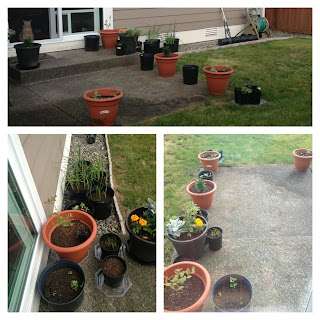Container colour seems to have an informal science behind it. Dark is good, dark is bad, light is good (have never read light is bad), and so it goes on about how container colour can impact the productivity of our container plants.
My container garden is large. I am also trying to keep it to as close to organically certifiable as possible (which has likely turned me certifiable in moments). I cannot escape the use of nursery trade pots. Budget disallows my preference for large terra cotta pots or even fiberglass wannabes. Did I mention the terra cotta is also good, but also bad?
Light pots tend to reflect light, thus leaving the container requiring less water on those particularly "warm" days.
Dark pots tend to absorb the light and heat, thus rendering the container a miniature oven for roots and requiring 1-2x, sometimes 3 waterings a day, depending on the latest and greatest information.
Terra cotta tend to leach their moisture, keep the soil cool, and crack in the winter. Personally, I've never had a terra cot pot of any size crack in winter, but I can certainly understand how that could happen. I do know they will keep the soil cool, but the claim that they lose their moisture is beyond me for I've never seen this, myself. Perhaps it is my location(s) that make that different.
My trade pots are black, a near black, and dark gray. This means my stealthy green friends may be warm and possibly be responsible for root scorching as the plants mature . We've hit some grand temperatures between the rain and storms. Even in the mid 60s, those pots are hot to the touch. For this season, I will be able to water at least twice a day and monitor them for hydration and evaporation. For the long term in container gardening, I don't think this is a great way to go, but you've got to use what you have, can get, or afford.
I had a large number of pots to purchase, so I purchased my plastic trade pots in small bulk. I much prefer the earthy feel of terra cotta, but I would have ended up with a few large and lovely terra cotta fixtures on the patio and no true container garden to speak of.
Moving on to the real question that begs to be answered, how do we mitigate the black trade pot?
Optionally, we could spray paint the pots (I was really considering glow in the dark paint, but at 70 pots, the investment did not really seem worthwhile and may have ended up a bit on the cheesy side of aesthetic appeal.
After all, we do have to look at these all season long!
Alternatively, in staying organic, we bought a truckload of nasturtiums ("Nasties"), Milkmaid, Alaska Mix, and Empress of India. Their companion-friendliness to almost all other vegetables precluded our decision to basically shove a few seeds in every pot.
"Why would you do that?", I imagine you are asking!
Well! It is our hope that the nasturtiums will grow, flowng over the sides of the pot in a pleasing cascade, essentially covering (and ultimately shading) the darkness of the container colour. Voila! Problem solved. Or so we hope!
Of course, it will take a bit for the nasties to fill and spill, but while the seedlings are young, that soil needs to be essentially warm and comfortable. With the spring rains still in the air, moisture is the least of the problems while then nasturtiums take over.
Bonus perk: if our garden absolutely fails, we at least have the nasturtiums to enjoy, both for eating and eye candy!
We may have possibly overdone the nasturtiums. . .






















.jpeg)




.jpg)
.jpg)
.jpg)
.jpg)
.jpg)
.jpg)
.jpg)
.jpg) Nasturtium (Milkmaid and Alaska Mix (Variegated)
Nasturtium (Milkmaid and Alaska Mix (Variegated).jpg)
.jpg)
.jpg)
.jpg)
.jpg)
.jpg)
.jpg)
.jpg)
.jpg)
.jpg)
.jpg)
.jpg)
.jpg)







